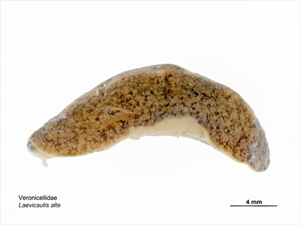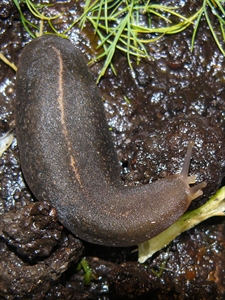- Restricted distribution. In Australia, American Samoa, Fiji, French Polynesia, New Caledonia, Papua New Guinea, Samoa, Vanuatu.
- Serious pest of vegetable seedlings and forestry species.
- Dark leathery body with pimples (70-80mm long) when moving, otherwise round, with characteristic yellow line along back, and narrow (4-5mm wide) foot. Mantle covers most of body. Occurs from lowlands to high forest. Adapted to dry areas.
- Spread: small distances gliding on mucus; longer distances associated with local and international horticultural trade.
- Biosecurity: considered potentially serious risk to agriculture (USA). Also, host of rat lungworm.
- Natural enemies: do NOT introduce predatory snails or flatworms.
- Cultural control: bands of sand or eggshells around small plots; collect by hand; use beer traps.
- Chemical control: metaldehyde pellets (check local regulations - potentially harmful to native birds and animals). Alternately, iron phosphate or sodium ferric EDTA. Indian runner ducks – they love slugs and snails!
Pacific Pests, Pathogens and Weeds - Online edition
Pacific Pests, Pathogens, Weeds & Pesticides
Tropical leatherleaf slug (475)
Tropical leatherleaf. It is also known as the lined leatherback slug, brown slug (in India), or black slug.
Laevicaulis alte; previously known as Vaginula alte, and Veginullus alte.
AUTHOR Grahame Jackson
Information from Brodie G, Barker GM (2012) Laevicaulis alte (Férussac, 1822). Family Veronicellidae. USP Introduced Land Snails of the Fiji Islands. Fact Sheet Series, No. 3; and Tropical leatherleaf. Wikipedia. (https://en.wikipedia.org/wiki/Tropical_leatherleaf); and from Laevicualis spp. Purdue University. (http://download.ceris.purdue.edu/file/2554). Photos 1&2 Michal Manas. Laevicaulis alte (Férussac, 1822). Wikipedia. (https://commons.wikimedia.org/wiki/File:Laevecaulis-2.jpg). Photo 3 MAF Plant Health & Environment Laboratory (2011) Tropical Leatherleaf Slug (Laevicaulis alte) (PaDIL - http://www.padil.gov.au.
Produced with support from the Australian Centre for International Agricultural Research under project HORT/2016/185: Responding to emerging pest and disease threats to horticulture in the Pacific islands, implemented by the University of Queensland and the Secretariat of the Pacific Community.






